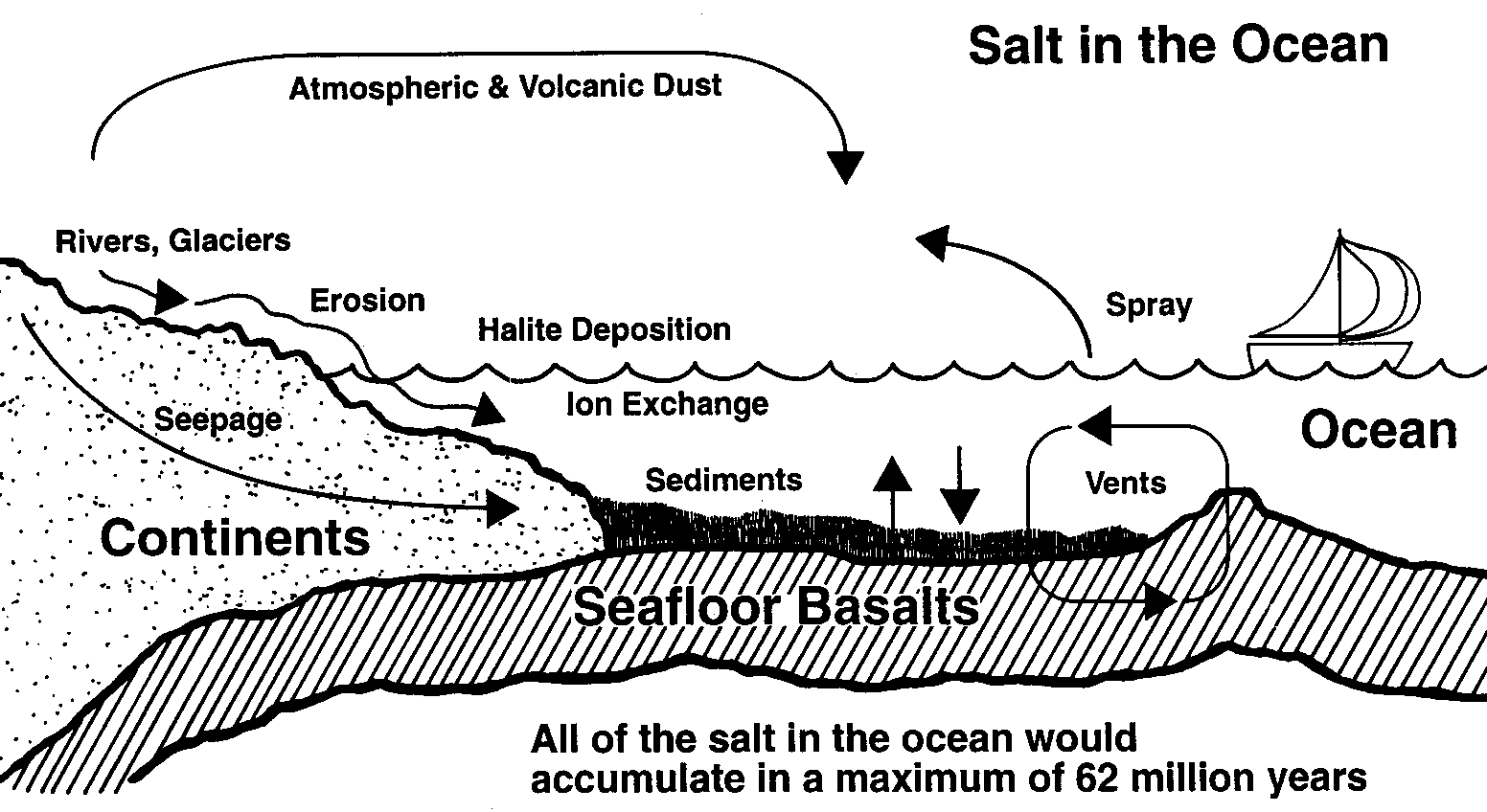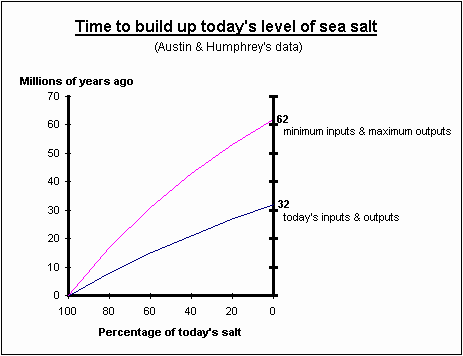|
|
Are the Oceans Old Enough to have Spawned Life? |
|
|
|
Are the Oceans Old Enough to have Spawned Life? |
|
by Laurence D Smart B.Sc.Agr., Dip.Ed., Grad.Dip.Ed
Email: laurence@unmaskingevolution.com
Webpage: www.unmaskingevolution.com
[Free to print and distribute. Copy must be in full.]
The Background
Evolutionists have traditionally assumed that life evolved in the oceans 3-4 billion years ago. This of course means that the oceans must be more than 3-4 billion years. So, how old are the oceans?
It is a scientific fact that the oceans are getting saltier. People don't notice that it is getting saltier over their lifetime, but it is. One only has to think of why the Dead Sea is so salty to realise that sea water is always getting saltier. River water entering the Dead Sea contains dissolved mineral salts that have come from the run-off of rainwater from the land. The Dead Sea is one of the lowest points on the surface of the earth - 400 m below sea level. Therefore, the water entering the Dead Sea cannot run out of it. The only water that leaves it is that which is evaporated out. When the water is evaporated out of the Dead Sea, it leaves the mineral salts behind. These build up over time, giving the Dead Sea its rather high saltiness.
The same phenomenon happens with the oceans. Water coming in from rivers bring with it dissolved salts. The oceans are the lowest points in their vicinity, so no water drains out of them. But, water is always being evaporated out. Much of the rain on the land surface comes from this water evaporated out of the oceans. When the water evaporates out of the oceans it leaves the salts behind, just like the Dead Sea. Therefore, the seas are always getting saltier - at a very, very slow rate.
If we assume that the water on the earth was originally fresh water with no salts dissolved in it, how long would it take for the oceans to become as salty as they are today? This salt build-up is a very useful chronometer. It is similar to the many time measuring tools scientists use to calculate measurements - they know what happens in the process, the rate at which the process proceeds, and so, they very accurately calculate the total time.
Joly's Calculation
In 1901 geologist John Joly (1) calculated the age of the earth by estimating how long it took for the ocean to become as salty as it was in his time. Using uniformitarian principles, he assumed that the seas were originally fresh water, and that the same amount of salt (sodium chloride) has been added to it each year since the world formed. He concluded that the earth was about 100 million years old. (2)
The age was calculated like this:-
Present concentration of ocean salt = 32 gm/lt
Present total volume of the oceans = 1.5 x 1021 lt
\ Present total amount of salt in the oceans = 32 x (1.5 x 1021) = 5 x 1016 tonnes
Present rate of salt entering the oceans = 5.4 x 108 tonnes/year
\ The time for the salt to reach the present value = (5 x 1016) ¸ (5.4 x 108) = 0.926 x 108 years
This is approximately = 100 million years
Joly's figure was readily accepted both as an age for the oceans, and as an approximate age for the earth. No other mathematically derived figures for the age of the earth were available at that time, so evolutionists 'ran' with the figure. An age of 260 million years was also calculated in 1965. (3)
Some Important Considerations
Since the advent of radio-dating, evolutionists have ignored salt calculations because they don't agree with their 3 billion-year requirement. Instead, they have developed theories to explain them away.
Joly's value was based on the assumption that everything has proceeded without change since the origin of the earth, and that the rate of salt build-up has always been the same. This is not a correct assumption.
More recently, investigators have identified the factors that add and remove salt from the sea. By taking these into account, a more accurate calculation of the age of the oceans can be made - including a maximum and a minimum possible age. These calculations are not theories, they are based on facts.

[Reproduced unchanged, with permission] (4)
Salt Adding Processes
Salt Removing Processes
Including an Earth History
To get a more accurate calculation of the age of the oceans, an earth history scenario needs to be added to the basic calculation. This takes into account events that would have most likely affected the salinity of the oceans. For example:-
The Calculation Data
The result of all these modern investigations has produced the following data measured in 1010 kg/yr (5):-
|
Sodium Input Process |
Modern |
Minimum |
Sodium Output Process |
Modern |
Maximum |
|
Rivers: Silicate Weathering |
6.2 |
6.2 |
Sea Spray |
6.0 |
6.7 |
|
Rivers: Chloride Solution |
7.5 |
7.5 |
Ion Exchange |
3.5 |
5.2 |
|
Rivers: Sea Spray |
5.5 |
5.0 |
Burial Pore Water |
2.2 |
3.9 |
|
Ocean-Floor Sediments |
11.5 |
6.21 |
Halite Deposits |
<0.004 |
4.0 |
|
Pulverized Glacial Sediments |
3.9 |
0.0 |
Alteration of Sea-Floor Basalt |
0.44 |
0.62 |
|
Atmospheric & Volcanic Dust |
0.14 |
0.14 |
Albite Formation |
0.0 |
0.0 |
|
Coastal Erosion |
0.077 |
0.074 |
Zeolite Formation |
0.08 |
0.2 |
|
Glacier Ice |
0.12 |
0.0 |
|
|
|
|
Volcanic Aerosols |
0.093 |
0.093 |
|
|
|
|
Ground Water Seepage |
9.6 |
9.3 |
|
|
|
|
Sea-Floor Hydrothermal Vents |
1.1 |
1.1 |
|
|
|
A More Accurate Calculation
In 1990, Dr Steven Austin and Dr Russell Humphreys (6) reworked the calculation for sea salt build-up (see Dr Morris' book for a summary) (7). The researchers took into account the factors that add salt to the sea, and the factors that remove salt from the sea. In this way they were able to derive a more accurate figure.
Using the modern measurements Austin and Humphreys calculated that the present ocean salt would accumulate in 32 million years. This means that at the present rate of addition and removal of salt from the oceans (following uniformatarian principles), the age of the oceans is 32 million years.
Using the data for minimum additions and maximum removals, Austin and Humphreys also calculated a maximum age for the oceans of 62 million years. They did this using following formula for time (T):-

This calculation estimated the oldest that the oceans could be. As far as science knows, there are no other processes that remove large amounts of salt from seawater. This means that the 62 million years is a ceiling. Any process that adds more salt means that the oceans are younger than 62 million years.
Discussion
The age of 62 million years is an estimate. No one knows exactly how old the oceans are - no human was there to record the starting date. It also assumes that there were no other major events that altered the rates. For example, no impact of a salty meteor or comet into the oceans; no global flood; no addition of fresh water from subterranean sources; no addition of fresh water from a canopy outside the atmosphere; no collision of earth with a water cloud from space; etc, etc.

(after Figure A) (8)
The calculation also assumes that the waters started fresh. This is an evolutionary concept. It states that the earth resulted from the condensation of a cloud of gas; the early planet was super heated due to nuclear fission events; the mass slowly cooled; the water condensed out of the air; collected in pools; which then became the oceans. If the seas were created salty to start with, then the maximum age of 62 million years needs major revision DOWNWARDS.
There are many other chronometers that measure the age of the oceans using the build-up of different minerals - 26 minerals give differing ages ranging from 100 years to 45 million years. (9)
Conclusions
(1) Austin and Humphrey's factual calculation demolishes the theory of a 3 billion-year age for the oceans.
(2) If - evolutionary theory states that life evolved in the oceans 3-4 billion years ago; and, the oceans are no older than 62 million years; then, the theory is nullified by this calculation.
(3) If - the evolutionary age of earth was being tested; then, we can reasonably and safely say from these calculations (by extrapolation), that the earth is nowhere near 5 billion years old.
REFERENCES
(1) J. Joly, "An Estimate of the Geological Age of the Earth", Smithsonian Institution Annual Report for the Year 1899, 1901 p:247
(2) I.T. Taylor, "In the Minds of Men: Darwin and the New World Order" (3rd ed), TFE Publishing: Toronto, 1992 p:288
(3) J.P. Riley & G Skirrow (eds), "Chemical Oceanography" Vol. 1, Academic Press: New York, 1965 p:164
(4) J.D. Morris, "The Young Earth", Master Books: Colorado Springs (USA), 1994 p:144
(5) S.A. Austin & D.R. Humphreys, "The Sea's Missing Salt: A Dilemma for Evolutionists", Proceedings of the Second International Conference on Creationism, Vol. 2, 1991 p:19 & 21
(6) S.A. Austin & D.R. Humphreys, "The Sea's Missing Salt: A Dilemma for Evolutionists", Proceedings of the Second International Conference on Creationism, Vol. 2, 1991 p:11-33
(7) J.D. Morris, "The Young Earth", Master Books: Colorado Springs (USA), 1994 p:85-87
(8) S.A. Austin & D.R. Humphreys, "The Sea's Missing Salt: A Dilemma for Evolutionists", Proceedings of the Second International Conference on Creationism, Vol. 2, 1991 p:33
(9) H. Morris & G.E. Parker, "What is Creation Science?", Master Books: Green Forest (USA), 1982 p:288-293
![]()